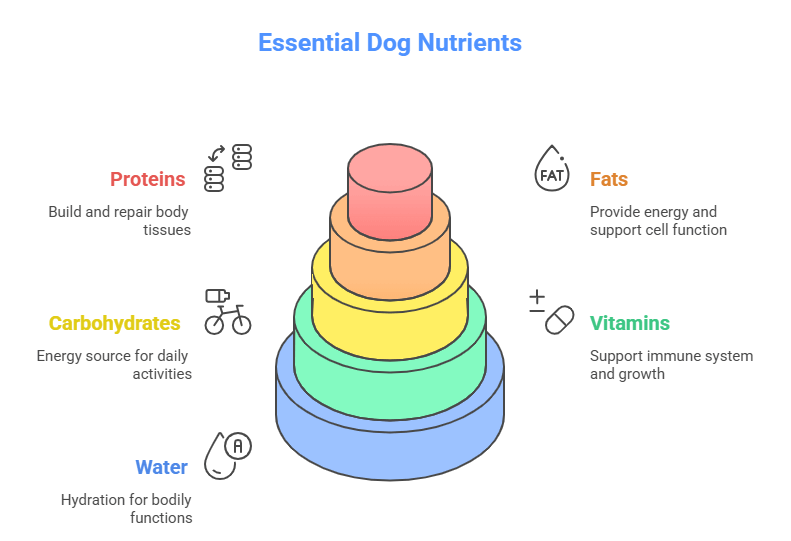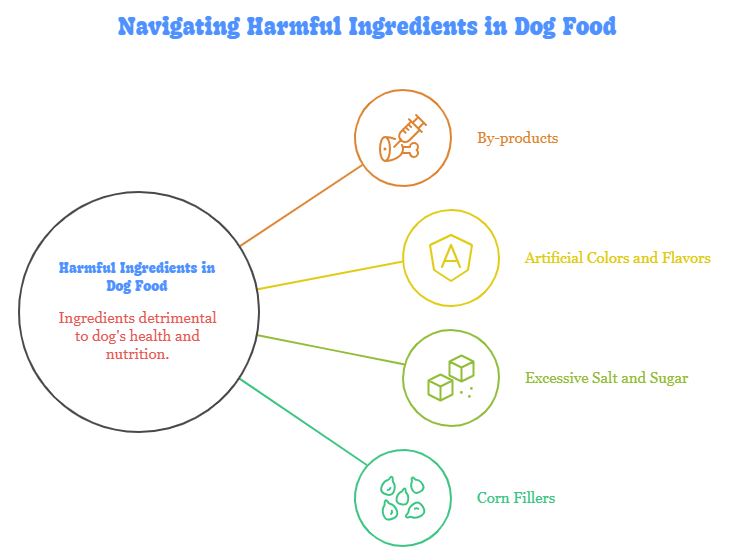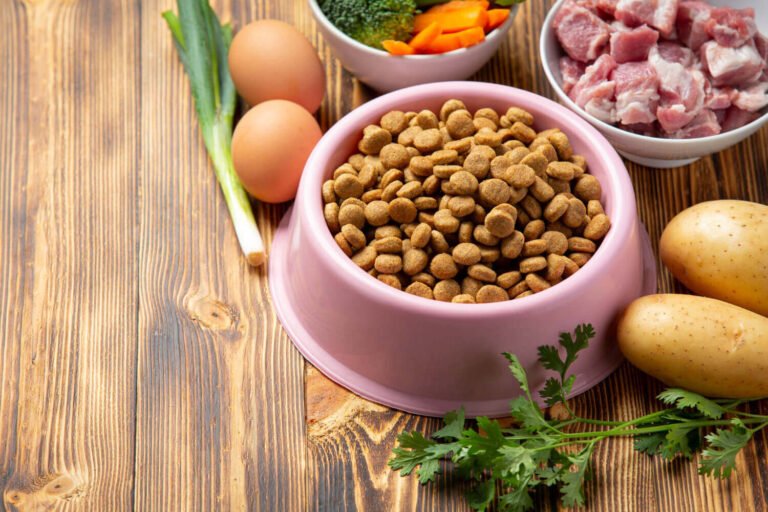Decoding Your Dog's Dinner Bowl
Dog food ingredients matter more than the flashy label on the bag. Let’s be honest—most dog parents assume that if it says “premium” or “natural,” it must be healthy. Right? Not always. The truth is, dog food marketing can be super misleading. Just because there’s a happy puppy on the front doesn’t mean what’s inside is good for your dog.
Knowing what’s actually in your dog’s food is crucial for their long-term health. The wrong dog food ingredients can cause allergies, tummy troubles, weight gain, and even serious illness. But the right ingredients? They help your pup thrive—supporting shiny coats, strong immunity, steady energy, and a longer, happier life.
In this guide, we’ll break down:
What nutrients dogs really need
Ingredients to love (and avoid)
How to decode confusing food labels like a pro
Disclaimer: This guide is based on expert research, but always talk to your vet before changing your dog’s diet—especially if they have health conditions.
The Building Blocks: Essential Nutrients Your Dog Needs
Dog food isn’t just about filling the bowl—it’s about fueling your dog’s body with what it truly needs. Let’s break it down:
A. Proteins: The Muscle Makers
Why It Matters:
Proteins are the foundation of your dog’s diet. They help build muscles, repair tissue, and support hormones and enzymes.
Top Ingredients to Look For:
Chicken
Beef
Lamb
Turkey
Salmon or whitefish
➡️ Look for named animal proteins at the top of the ingredient list (like “Deboned Chicken” or “Lamb Meal”). Avoid vague terms like “meat by-product.”
B. Fats: Energy + Skin & Coat Care
Why It Matters:
Healthy fats give your dog energy and keep their skin soft and coat shiny.
Top Ingredients to Look For:
Chicken Fat
Salmon Oil
Flaxseed Oil
Bonus: Omega-3 fatty acids (from fish oil) are great for joint support and brain health.
C. Carbohydrates: Not All Bad!
Why It Matters:
Carbs give energy and fiber. They help with digestion and satiety.
Good Sources:
Sweet Potatoes
Brown Rice
Oats
Peas
Avoid low-nutrition fillers like corn gluten or wheat middlings.
D. Vitamins & Minerals: The Micro-Nutrient Heroes
Why It Matters:
Vitamins and minerals boost your dog’s immune system, bone strength, and metabolism.
Where to Find Them:
In whole foods (like spinach, carrots, pumpkin)
In high-quality supplements added to food
E. Water: The Forgotten Essential
Why It Matters:
Water supports every function—from temperature regulation to digestion.
Even with dry kibble, dogs need access to clean, fresh water at all times.
Wet food contains more moisture—helpful for dogs who don’t drink much.

🔗 External Resource: American Kennel Club: Dog Nutrition Basics
Ingredients You Want to See in Dog Food
It’s not about finding the fanciest brand—it’s about knowing what goes inside. Here’s what good dog food ingredients actually look like on the label:
Real Animal Proteins (Named Sources)
You want to see things like “Chicken,” “Beef,” “Turkey,” or “Lamb” listed as the first ingredient. That tells you it’s protein-rich, not just filler-based.
Look for:
Deboned chicken
Salmon
Turkey meal
Lamb
Duck
Avoid anything that just says “meat” or “animal meal”—you never know what you’re getting.
Whole Grains or Healthy Carbs (If Included)
Not all carbs are bad. In fact, whole grains provide steady energy and help digestion.
Look for:
Brown rice
Oatmeal
Quinoa
Barley
Sweet potatoes
If your pup is grain-sensitive, go for grain-free options with sweet potatoes or peas instead.
Named Fats & Oils
Good fats are vital for energy, brain function, and a glossy coat.
Look for:
Chicken fat
Salmon oil
Flaxseed oil
Coconut oil
And yes, “omega-3” or “DHA” on the label is a great bonus—especially for puppies and seniors.
Fruits & Vegetables
Yep—dogs need their veggies too! They offer antioxidants, fiber, and natural vitamins.
Look for:
Carrots
Spinach
Blueberries
Pumpkin
Apples (no seeds)
These help with digestion, immunity, and skin health.
Supplements & Additives That Help
Don’t be scared of some additives—they can actually boost health if done right.
Look for:
Glucosamine and chondroitin (for joint support)
Probiotics (for digestion)
Taurine (for heart health)
L-carnitine (helps metabolize fat)
Fun Fact: Taurine is especially important for heart health in breeds like Golden Retrievers.
Want more science? Tufts University’s Pet Nutrition site is packed with vet-approved research.
Ingredients to Avoid in Dog Food (Red Flags!)

Okay, now let’s flip the bowl. These are the sneaky ingredients that may sound okay—but aren’t.
By-products (Unspecified Sources)
“Meat by-product” or “animal digest” could mean anything from bones to beaks—yikes!
Avoid:
Poultry by-product meal
Animal fat (unspecified)
Meat meal (unless labeled like “Chicken Meal”)
Cheap Fillers
These just bulk up the food without offering real nutrition—and they can cause allergies or upset stomachs.
Avoid:
Corn gluten meal
Wheat middlings
Soybean hulls
Brewer’s rice
Artificial Colors & Flavors
Dogs don’t care what color the food is—but their bodies do care about chemical dyes and fake flavors.
Avoid:
Red 40, Blue 2, Yellow 5
BHA, BHT, and Ethoxyquin (preservatives linked to cancer)
Tip: If the ingredients list sounds more like a chemistry class than a food label… back away slowly.
Excessive Salt & Sugar
Some brands sneak in sugar and salt to make the food more “palatable”—but it’s harmful long-term.
Watch out for:
Corn syrup
Fructose
Salt high on the list
How to Read a Dog Food Label Like a Pro
Dog food labels can feel like a maze of marketing buzzwords and scientific terms. But once you know what to look for, you’ll start spotting red flags—or high-quality choices—in seconds.
Here’s how to decode it:
1. Ingredient Order Matters (A LOT)
Ingredients are listed by weight—so the first 3–5 items tell you most of what’s in the bag.
Example:
Good: Chicken, sweet potato, brown rice, chicken meal
Not so good: Corn, chicken by-product meal, wheat gluten
If corn or soy comes first? Time to move on.
2. Look for the AAFCO Statement
This confirms the food meets nutritional standards set by the Association of American Feed Control Officials (AAFCO).
Look for:
“This food is formulated to meet the nutritional levels established by the AAFCO Dog Food Nutrient Profiles…”
🚫 Avoid: Brands that don’t have this line—especially if they call themselves “supplement” or “for intermittent feeding only.”
3. Watch for Sneaky Ingredient Splitting
Sometimes brands break up fillers (like corn, rice, or soy) into smaller parts to hide how dominant they are.
Example:
“Corn gluten meal, ground corn, corn bran” — seems like less, but it’s mostly corn!
4. Guaranteed Analysis = Nutrient Snapshot
This shows the minimum or maximum levels of key nutrients:
Protein
Fat
Fiber
Moisture
Use it to compare protein % between brands (but compare dry matter basis for accuracy).
Special Ingredient Needs for Puppies, Seniors & Dogs with Allergies
Not all dogs should eat the same formula. Age, allergies, and health conditions can change what ingredients are safe—or even beneficial—for your pup.
Here’s how to adjust based on your dog’s specific needs:
For Puppies (Growth & Development)
Puppies need more protein, DHA, and fat to support their rapid growth, brain development, and active lifestyle.
Ingredients to look for:
High-quality protein (chicken, lamb, fish)
DHA (from fish oil—for brain and vision)
Calcium & phosphorus (for bones and teeth)
Eggs or liver (for natural vitamin A and iron)
Choose a formula labeled “For All Life Stages” or “Puppy” and make sure it’s AAFCO-approved.
For Senior Dogs (Age 7+)
Older dogs need easier-to-digest proteins and ingredients that support joint health and digestion.
Look for:
Lean protein (like turkey or salmon)
Joint support: Glucosamine and chondroitin
Antioxidants: Blueberries, spinach, turmeric
Fiber & probiotics (for healthy digestion)
⛔ Avoid: High-fat or calorie-dense foods that may lead to weight gain.
Want to more detail about which food, diet best for dog by breed size check out this detailed guide
For Dogs with Allergies or Food Sensitivities
Signs like itching, ear infections, or chronic diarrhea may point to a food intolerance.
Try:
Limited ingredient diets
Novel proteins like duck, venison, or kangaroo
Grain-free or single-grain options
No artificial additives, corn, soy, or wheat
Tip: Elimination diets are the gold standard to identify allergens—best done under a vet’s guidance.
DIY vs. Commercial Dog Food Ingredients – What You Should Know
There’s a growing trend among dog parents wanting to cook for their pups at home. It feels personal, loving, and natural. But is homemade food really better than commercial kibble or wet food? Let’s unpack the truth about DIY vs. commercial dog food ingredients.
Homemade Dog Food: What’s Good & What’s Tricky
Homemade food gives you full control over what goes into your dog’s bowl. No mystery meat, no hidden preservatives—just real food.
Pros:
Fresh, whole ingredients
Customizable for allergies or picky eaters
No fillers or artificial stuff
Cons:
- Nutritional balance is hard to achieve
Time-consuming to prepare
Easy to overdo or miss key nutrients like calcium, taurine, or essential fatty acids
Important: Homemade diets must be vet-formulated or reviewed by a certified veterinary nutritionist. A scoop of rice and chicken isn’t enough for long-term health.
Commercial Dog Food: Not All Bad
Commercial dog food often gets a bad rap, but there are many high-quality brands using carefully tested, balanced recipes that meet AAFCO standards.
Benefits:
- Scientifically formulated with complete nutrients
Easy to store and serve
Available in options for every budget, breed, and health condition
Watch out for:
- Low-quality meat meals and by-products
Artificial colors and preservatives
Fillers like corn gluten, soy, or excessive grains
Tip: Always check that the product is “complete and balanced” and has a named protein as the first ingredient.
What Ingredients Work Well in Both DIY & Store-Bought Options?
Whether you’re cooking at home or buying a bag, look for:
Lean meats (chicken, turkey, beef, fish)
Sweet potatoes, carrots, green beans
Blueberries, pumpkin, spinach
Salmon oil or flaxseed for healthy fats
Probiotics and prebiotics for digestion
These ingredients are safe and nutritious in both homemade and commercial food—if portioned and balanced right.
Sneaky Ingredients to Watch Out For (and Why They're Used)
Alright, time to expose the shady side of some dog food labels. Just because something is “approved” doesn’t mean it’s ideal for your pup. Many commercial dog foods include sneaky ingredients that serve manufacturers more than your dog’s health.
Let’s look at what to avoid—and why.
1.Meat By-Products
You might see terms like “chicken by-product meal” or “meat meal” on labels.
What it really means:
Ground-up leftovers like feet, beaks, organs, and sometimes low-quality scraps not fit for human consumption.
Why they use it: It’s cheap protein.
Look for instead:
Whole, named meats like “chicken,” “beef,” or “lamb” listed first on the label.
2. Artificial Colors & Flavors
Red 40, Blue 2, Yellow 5… yeah, your dog doesn’t care what color their kibble is.
Why it’s there:
To make the food look more appealing to humans, not dogs.
Problem:
These can trigger allergies and hyperactivity. Long-term exposure? Not worth the risk.
3. Preservatives You Can’t Pronounce (BHA, BHT, Ethoxyquin)
Used to extend shelf life. But these synthetic chemicals are linked to potential health risks—some even flagged as carcinogens in certain studies.
Better alternatives:
Natural preservatives like mixed tocopherols (Vitamin E), rosemary extract, or citric acid.
4. Corn, Wheat, and Soy as Primary Ingredients
These fillers bulk up the food but don’t offer much nutrition.
Dogs can digest grains, but when they’re the main ingredient, you’re paying for fluff, not fuel.
They can also trigger food allergies in some dogs, especially corn gluten meal.
5. Generic “Animal Fat” or “Animal Digest”
Pet food marketing can be sneaky. Just because it says “all-natural” or “holistic” doesn’t mean it’s suitable for dogs with food sensitivities or allergies. Always check the first 5 ingredients, the protein source, and whether it’s marked “complete and balanced” for your dog’s life stage.
Look for the AAFCO nutritional adequacy statement—it’s one of the most important lines on the package.
Ignoring Treats and Table Scraps
Vague terms that hide the origin of the ingredients. Could be anything—and often from low-quality sources.
- Look instead for named fats like “chicken fat” or “salmon oil.”
BONUS TIP:
If the label says “With Real Beef,” that only means 3% beef is required. Marketing language can be deceiving—always check the ingredient list, not just the front of the bag.
🔗 Useful Resource:
Understanding Pet Food Labels – FDA.gov
Reading Dog Food Labels: A Quick, No-Nonsense Guide
Ever felt like reading a dog food label is like trying to crack a secret code? You’re not alone. But once you know what to look for, it’s actually pretty simple—and super powerful for making better choices.
Here’s your no-fluff guide to reading dog food labels like a pro.
1. Check the First 5 Ingredients
The first five ingredients make up most of what your dog is actually eating.
Look for real, whole foods like:
Chicken
Turkey
Lamb
Salmon
Sweet potatoes
Brown rice
Avoid when the first ingredient is something like “corn” or “meat by-product.”
2. Decode “Guaranteed Analysis”
This shows the minimum percentages of:
Crude protein
Crude fat
Crude fiber
Moisture
➡️ A good dog food typically has at least 18% protein for adults and 22%+ for puppies.
Tip: If the protein is coming from whole meats (like deboned chicken), you’re good. But if it’s mostly from plant sources, it’s not as high-quality.
3. Understand the Ingredient Splitting Trick
Ever see rice, brown rice, and rice bran listed separately?
That’s ingredient splitting—used to push a meat ingredient up the list by breaking up fillers into smaller parts.
Rule: Always ask, “What’s the total grain or filler content overall?”
4. Watch for Buzzwords (but don’t trust them blindly)
“Premium” and “natural” don’t mean much—there’s no legal standard for these terms.
“With real beef” only requires 3% beef.
“Grain-free” might still be loaded with fillers like peas and potatoes.
Learn to read the full ingredient list, not just the packaging hype.
5. Look for AAFCO Nutritional Adequacy Statement
This line tells you if the food is complete and balanced for your dog’s life stage.
It might read:
“This food is formulated to meet the nutritional levels established by the AAFCO Dog Food Nutrient Profiles for adult maintenance.”
Avoid foods that don’t have this unless directed by a vet.
FAQs on Dog Food Ingredients
What are the healthiest ingredients to look for in dog food?
Look for whole meats like chicken, beef, or lamb, along with brown rice, sweet potatoes, salmon, flaxseed, and real fruits or veggies. These support your dog’s energy, immunity, and coat health.
What dog food ingredients should I avoid completely?
Avoid artificial preservatives (BHA, BHT), colors, meat by-products, generic “animal fat,” corn syrup, and MSG. These offer zero nutritional value and may trigger allergies or long-term health issues.
How can I tell if my dog is allergic to an ingredient?
Common signs of a food allergy include itching, ear infections, vomiting, soft stools, or constant paw licking. Try an elimination diet or talk to your vet about allergy testing.
Is “by-product meal” the same as real meat?
Nope! By-product meals often include less desirable animal parts like organs, beaks, or bones—not actual meat muscle. Always choose named meats like “chicken meal” or “salmon” over vague by-products.
What does “natural” mean on a dog food label?
Not much, honestly. “Natural” is a vague term and isn’t strictly regulated. Always check the full ingredient list instead of relying on buzzwords on the packaging.
Are artificial flavors and colors bad for dogs?
Yes. These additives can cause allergies, hyperactivity, and long-term health problems. Go for foods with naturally flavored ingredients like meat, fish, or herbs.
How much protein should be in my dog’s food?
For adult dogs, aim for at least 18% protein, and for puppies, around 22-25%. Active or working dogs may need even more. Quality matters too—animal protein is always better than plant-based fillers.
What’s the best way to compare dog food brands?
Use a Dog Food Comparison Tool (like the one on our site) to check ingredients, protein content, cost per pound, and brand transparency. Don’t just compare prices—compare nutrition too.
Try the Dog Food Comparison Tool
Can I feed my dog homemade food instead of commercial kibble?
Yes, but it must be well-balanced. Homemade food can be great—but without the right ratios of protein, fat, carbs, and vitamins, it may harm your dog. Always consult a vet or canine nutritionist before switching.
Think of it like giving your dog a fresh start. If they’ve always eaten chicken or beef, switching to duck or fish can reduce flare-ups.




